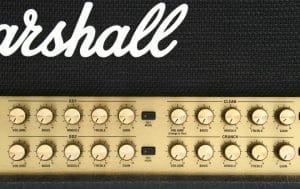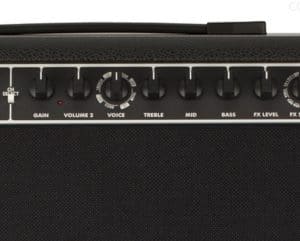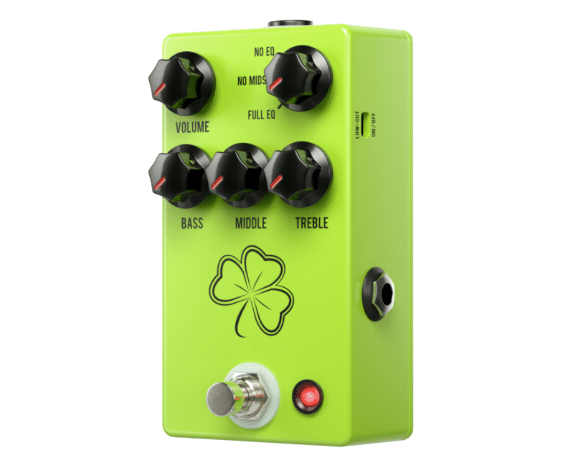Gain is one of the most commonly used settings of a guitar amplifier. But a lot of guitar players don’t actually understand what gain does on a guitar amp. What’s the best setting? Does the “more means better” rule work here? Is gain the same as volume?
There are a lot of questions, and it’s totally fine. These settings will need some time and skill to master, and this article should help you figure the basics out. Keep in mind that you’ll need some knowledge of your amplifier’s functionality to achieve the best sound.
The Function of Guitar Amp Gain and What Preamp Has to Do with It
Table of Contents
Gain is responsible for the increase in electrical signal power. It makes the sound cleaner or more distorted. The major mistake guitarists make is using it as an additional volume knob. In reality, though, its function is different.
There are two stages the sound goes through before its output:
- Preamp stage
- Poweramp stage
Gain is only active during the preamp stage. It’s responsible for amplifying the actual electric signal that goes from your guitar through cords to the device. The signal is shaped and changed before going to the next stage and out the speakers. Aside from gain, bass, mid, and treble are also applied within preamp.
There are other names for gain: distortion, channel volume, drive, etc. But all these names usually mean the same. Some amps can have “PREAMP” written above the knob to emphasize its main function.
Gain, Contour, Volume, and Master Difference

When buying an amplifier, you should be knowledgeable of its functions and settings. Every function can make a difference to the final sound you’ll get. Some settings may confuse you:
- Gain
Gain is making your sound clear or dirty. Higher settings overload the preamp stage more, getting distortions in the final result. This isn’t connected to the volume, as even the quietest setting will sound distorted if there’s too much gain.
- Contour
Contour is a control found on most Marshall guitar amplifiers and controls the mid-range frequencies but in a different way than the Mid setting. When increasing, it decreases mid and vice versa. Keep it in mind when using contour to change your sound.

- Ideal for rehearsals and home practice” Celestion speakers
- 4 voicings in 2 channels
- Volume
Volume is responsible for the intensity of your sound. If an amp has different channels, there should be a volume knob for each of them. You have to make sure they’re all at the same level so that you don’t have jumps in sound when switching channels. Two knobs usually mean clean and distorted channel volumes; one knob acts as a master.
- Master
Master is responsible for the overall volume of all channels. It’s active in the second stage of the amplification – power amp. It defines the strength of your sound, with all the other settings (bass, mid, treble, gain) already applied.
The major confusion of gain vs volume
First one may make your guitar sound louder. But it also impacts other elements of the final result, while the volume knob is only responsible for how loud the output sound is.
Another confusion is between volume and master volume. The difference is simple: the first one controls the output of one channel, the second one – of the whole amp. You can have one or two knobs, depending on the model. The master one will be indicated but you still have to see if there are other volume knobs to make sure you get a stable sound.
Contour and the mid difference are also easy to understand since the first one is a kind of Marshall exclusive. They both control mid-range but in opposite ways. Middle-range frequencies give your sound more depth. They should provide wholesomeness to the song, which calls for a higher mid/lower contour.
Overview of Gain Settings on a Guitar Amp

Lower settings will give you a cleaner, calmer sound which is great for blues songs or home practice. The 12 o’clock one will give your sound some character without providing too much distortion. Higher settings will get you more of a rock/metal sound, very distinct and distorted, even crispy.
Your setting choice should be based on the sound you want to get from the amplifier. Tip: use less gain that you initially think is needed. It’s clear that you might want to achieve the crispiness right away, but too much of it might distort the song. This especially applies to live performances, where every small mistake is visible.
High Gain Vs Low Gain Guitar Amps: Which One to Choose?
As to the best gain settings for a guitar amp, they depend entirely on the sound you’re after and the songs you’re about to play:
- Classic, blues, ballads, and other calmer songs require low gain. You want to sound clear, sweet, and pleasant;
- Rock-n-roll and classic rock require more character, therefore more gain;
- Heavier songs allow for higher gain for powerful, crisp sound.
You should decide how much gain is too much by experimenting with your amp. But make sure you do it before going live and opt for a slightly lower gain before the gig. When playing live, small mistakes are amplified along with the overall sound, and you don’t want your perfect guitar solos to sound like a bowl of mush.
Pedal Preamp: What It Is and How It Works
Pedal preamps are also called stompboxes. These are smaller amplifiers that allow you to control your sound tone mid-performance. They have one or a combination of knobs. The most common is a boost knob, so you can get a pedal with just this function. But there are also devices with more EQ (equalizer, tone) settings and clean boost.

- Will push your small wattage amp into natural rich overdrive and distortion” Celestion speakers
- Stratocaster and Telecaster players can use the pedal to create extra punch, depth and dynamics
In your set, it should be placed between the guitar and the amplifier.
A preamp pedal essentially takes the signal from your guitar, boosts it, increasing its gain/volume/other characteristics, and sends further to the amplifier. You can get multiple pedals for different settings and functions, getting more control over your final sound during performances.
Gain means as much as bass and treble settings, and master volume has no power until the preamp is done. So it’s a good idea to get a pedal or two. Essentially, all of them much have preamp so that your amplifier gets an already modified sound.
Summary
Gain is one of those fundamental settings. It controls the strength of the electric signal that goes to the amp through the preamp stage. This is where your knowledge of the functionality should help. Learn more about the phases, presets, or channels, and how they impact your output sound.
You should remember that more is not necessarily better in this case. Be careful when setting gain, as even a small change can make your sound perfectly clear or awfully distorted (which can be good for some solos as well). Determine the sound style you’re going for at the moment and use correct settings to get the sound you want!

Leave a Reply
You must be logged in to post a comment.